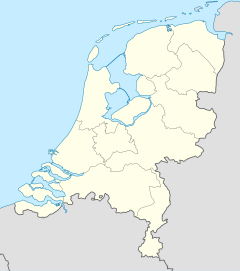Weesp train disaster

Damage after the Weesp train disaster
|
|
| Date | 13 September 1918 |
|---|---|
| Location | Weesp, North Holland |
| Country | Netherlands |
| Rail line | Amsterdam–Zutphen railway |
| Operator | Hollandsche IJzeren Spoorweg-Maatschappij |
| Type of incident | Derailment |
| Cause | Embankment collapse |
| Statistics | |
| Trains | 1 |
| Deaths | 41 |
| Injuries | 42 |
The Weesp train disaster took place on 13 September 1918 near Weesp in the Netherlands. With 41 deaths and 42 injured, it was the largest train disaster in Dutch railway history until 1962 when the Harmelen train disaster occurred.
The 102 train from Amersfoort to Amsterdam derailed near the railway bridge over the Merwedekanaal near Weesp and dropped off the bank. Various wooden carriages were splintered, causing many casualties in them.
The train was composed of two parts. The front carriages came from Zwolle, the rear ones from Enschede. In Hilversum another carriage was hooked on, making a total of 11 carriages, which were pulled by the locomotive HSM 520. The departure time was 9.46 from Amersfoort and 10.10 from Hilversum. According to the schedule the train should have arrived in Amsterdam at 10.40.
While riding up the slope of the Weesp station towards the bridge over the Merwedekanaal the dike sagged over a length of 95 metres. This was caused by the extensive rain in the preceding time and the poor state of repair of the railway dike. At the moment of the sagging the locomotive already was on the bridge and was entangled in the ironworks of the bridge construction. The locomotive and tender flipped to the right. The tender lay on the bridgehead, a luggage wagon next to it came to a standstill against the bridgehead. The following three carriages slid off the slope and shoved into each other. The wooden upperside was largely splintered, causing the most deaths and injured. The third carriage was also engulfed by the luggage carriage on the rear and a postal carriage, which because of the speed partially ended up next to the forward carriages. The carriage behind the postal carriage ended up skewed down from the slope, but was barely damaged. The rear carriages of the train derailed but remained on the tracks.
The disaster happened at 10.25. Two minutes before a train from Amsterdam to Hilversum passed. The station chief of Weesp station sounded the alarm at 10.45. A surgeon who happened to be on the train took care of first aid, soon assisted by two doctors rushed in from Weesp. Four nuns also gave aid, as well as soldiers who happened to be in the neighbourhood. There were no victims within the train's personnel, they also helped shortly after the disaster.
...
Wikipedia

